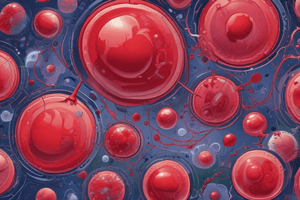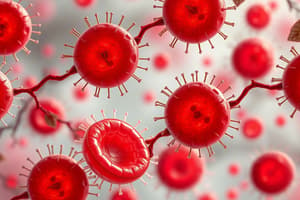Podcast
Questions and Answers
What is the normal range for absolute reticulocyte count in the absence of anemia?
What is the normal range for absolute reticulocyte count in the absence of anemia?
- 25,000 - 75,000/μL (correct)
- 75,000 - 150,000/μL
- 10,000 - 50,000/μL
- 50,000 - 100,000/μL
An absolute reticulocyte count of less than 75,000/μL in the presence of anemia indicates which of the following?
An absolute reticulocyte count of less than 75,000/μL in the presence of anemia indicates which of the following?
- Hemolysis
- Normal reticulocyte count
- Appropriate erythropoietic response to blood loss
- Hypoproliferative process (correct)
What does an absolute reticulocyte count greater than 100,000/μL suggest in the presence of anemia?
What does an absolute reticulocyte count greater than 100,000/μL suggest in the presence of anemia?
- Hypoproliferative process
- Normal reticulocyte count
- Hemolysis or an appropriate erythropoietic response to blood loss (correct)
- Anemia is not present
What two parameters from the Complete Blood Count are most useful in classifying anemia?
What two parameters from the Complete Blood Count are most useful in classifying anemia?
What does MCV reflect?
What does MCV reflect?
What does RDW represent?
What does RDW represent?
What does the finding of hypersegmented neutrophils on a peripheral blood smear suggest?
What does the finding of hypersegmented neutrophils on a peripheral blood smear suggest?
Why is reviewing a peripheral blood smear an important diagnostic procedure?
Why is reviewing a peripheral blood smear an important diagnostic procedure?
What is the primary role of erythropoietin (EPO) in the body?
What is the primary role of erythropoietin (EPO) in the body?
Which of the following correctly describes the structure of mammalian erythrocytes?
Which of the following correctly describes the structure of mammalian erythrocytes?
Which measurement is NOT routinely conducted for erythrocytes?
Which measurement is NOT routinely conducted for erythrocytes?
What is the significance of the biconcave shape of erythrocytes?
What is the significance of the biconcave shape of erythrocytes?
In the hematopoietic process, what do myeloid progenitor cells give rise to?
In the hematopoietic process, what do myeloid progenitor cells give rise to?
What defines anemia as a clinical state?
What defines anemia as a clinical state?
Which type of anemia is associated with chronic blood loss leading to iron deficiency?
Which type of anemia is associated with chronic blood loss leading to iron deficiency?
Which parameter is particularly important in evaluating anemia?
Which parameter is particularly important in evaluating anemia?
What might impairment of erythropoietin production be associated with?
What might impairment of erythropoietin production be associated with?
Which of the following can suggest a possibility of autoimmune hemolytic anemia?
Which of the following can suggest a possibility of autoimmune hemolytic anemia?
In the context of anemia, what is a potential consequence of occupational exposure to lead?
In the context of anemia, what is a potential consequence of occupational exposure to lead?
What is the role of reticulocyte count in diagnosing anemia?
What is the role of reticulocyte count in diagnosing anemia?
Which nutrient's dietary history is particularly important in evaluating anemia?
Which nutrient's dietary history is particularly important in evaluating anemia?
What condition may present from congenital anemias in adults?
What condition may present from congenital anemias in adults?
Which symptom is commonly associated with iron-deficiency anemia?
Which symptom is commonly associated with iron-deficiency anemia?
In cases of congenital hemolytic anemia, splenomegaly is likely to be present when?
In cases of congenital hemolytic anemia, splenomegaly is likely to be present when?
What does an increased cardiac murmur in an anemic patient indicate?
What does an increased cardiac murmur in an anemic patient indicate?
What is the primary purpose of measuring reticulocyte count?
What is the primary purpose of measuring reticulocyte count?
When is it preferable to use manual counting methods for reticulocyte count?
When is it preferable to use manual counting methods for reticulocyte count?
What adjustment is needed when reticulocyte count is reported as a percentage?
What adjustment is needed when reticulocyte count is reported as a percentage?
Neurologic manifestations in anemia associated with vitamin B12 deficiency are relevant because they can:
Neurologic manifestations in anemia associated with vitamin B12 deficiency are relevant because they can:
Flashcards
Hematology
Hematology
The study of blood cellular elements and their morphology.
Pluripotent stem cells
Pluripotent stem cells
Rare cells that divide slowly and give rise to myeloid and lymphoid lineages.
Myeloid lineage
Myeloid lineage
Stem cell lineage producing cells for erythropoiesis, thrombopoiesis, and more.
Erythropoietin (EPO)
Erythropoietin (EPO)
Signup and view all the flashcards
RBC measurements
RBC measurements
Signup and view all the flashcards
Mean Corpuscular Volume (MCV)
Mean Corpuscular Volume (MCV)
Signup and view all the flashcards
Mean Corpuscular Hemoglobin Concentration (MCHC)
Mean Corpuscular Hemoglobin Concentration (MCHC)
Signup and view all the flashcards
Anemia
Anemia
Signup and view all the flashcards
Blood loss anemia
Blood loss anemia
Signup and view all the flashcards
Hypoproliferative anemia
Hypoproliferative anemia
Signup and view all the flashcards
Hemolytic anemia
Hemolytic anemia
Signup and view all the flashcards
Reticulocyte count
Reticulocyte count
Signup and view all the flashcards
Peripheral blood smear
Peripheral blood smear
Signup and view all the flashcards
Congenital Anemias
Congenital Anemias
Signup and view all the flashcards
Angular Cheilitis
Angular Cheilitis
Signup and view all the flashcards
Koilonychia
Koilonychia
Signup and view all the flashcards
Splenomegaly
Splenomegaly
Signup and view all the flashcards
Systolic Cardiac Murmurs
Systolic Cardiac Murmurs
Signup and view all the flashcards
Vitamin B12 Deficiency
Vitamin B12 Deficiency
Signup and view all the flashcards
Absolute Reticulocyte Count
Absolute Reticulocyte Count
Signup and view all the flashcards
Normal reticulocyte count
Normal reticulocyte count
Signup and view all the flashcards
Hemolysis response
Hemolysis response
Signup and view all the flashcards
Red Blood Cell Distribution Width (RDW)
Red Blood Cell Distribution Width (RDW)
Signup and view all the flashcards
Peripheral blood smear importance
Peripheral blood smear importance
Signup and view all the flashcards
Hypersegmented neutrophils
Hypersegmented neutrophils
Signup and view all the flashcards
Bone marrow biopsy
Bone marrow biopsy
Signup and view all the flashcards
Study Notes
Clinical Hematology - Lecture N1
- Hematology studies the numbers and morphology of blood cells (RBCs, WBCs, and platelets) and how these results help diagnose and monitor disease.
Origin and Differentiative Stages of Circulating Blood Cells
- Pluripotent hemopoietic stem cells divide slowly, maintaining their own population and giving rise to myeloid and lymphoid progenitor cells.
- Myeloid lineage precursors (blasts) are for erythropoiesis, thrombopoiesis, granulopoiesis, and monocytopoiesis, all in the bone marrow.
- Lymphoid lineage forms B and T lymphocytes and natural killer cells in lymphoid organs.
- Erythropoietin (EPO), colony-stimulating factors (CSFs), and growth factors promote growth and differentiation.
Products and Functions of Blood Cells
- Erythrocytes: Main product is hemoglobin, main function is transporting CO₂ and O₂.
- Leukocytes (Neutrophils, Eosinophils, Basophils): Specific granules and modified lysosomes; phagocytosis of bacteria, defense against parasites, release of mediators.
- Monocytes: Granules with lysosomal enzymes; generate mononuclear phagocytes, phagocytosis, digestion.
- Lymphocytes (B and T): Immunoglobulins; kill virus-infected cells.
- Natural Killer Cells (NK): kill virus-infected and some tumor cells
- Platelets: Blood-clotting factors; clotting of blood
Composition of Whole Blood
- Whole blood consists of plasma and formed elements.
- Plasma contains amino acids, nutrients, proteins (albumins, fibrinogen, globulins), electrolytes, gases, and nitrogenous waste.
- Formed elements include platelets, leukocytes (granulocytes and agranulocytes), and erythrocytes.
Erythrocytes
- Erythrocytes, or red blood cells, are anucleated and packed with hemoglobin.
- They are biconcave disks without nuclei.
- Their shape provides a large surface-to-volume ratio, enabling efficient gas exchange.
- Human erythrocytes are typically 7.5 micrometers in diameter.
RBC Measurements
- Packed cell volume (PCV), hemoglobin concentration, and RBC count are done to measure RBCs.
- These measurements allow for calculation of Mean Corpuscular Volume (MCV) and Mean Corpuscular Hemoglobin Concentration (MCHC).
Approach to Anemia in the Adult
- Anemia is a clinical state of low red blood cell mass.
- It's defined as a reduction in the red blood cell mass.
Mechanisms of Anemia
- Three main categories of anemia: blood loss, hypoproliferative, and hemolytic anemias.
- Blood loss can be acute or chronic. Acute cases initially don't show a drop in hemoglobin due to the time needed for plasma volume restoration. Chronic blood loss eventually causes hypoproliferative anemia due to iron deficiency.
Erythropoiesis
- Erythropoiesis is the process of red blood cell production.
- Hypoxia stimulates the kidney to produce erythropoietin.
- Erythropoietin stimulates the bone marrow to produce more red blood cells.
Anemia Classification
- Categorized as absolute or relative (increased plasma volume).
- Can be acquired or hereditary.
- Can be based on red cell production or destruction.
- Includes a range of causes, e.g., mechanical damage, antibody issues, chemical injury, physical injury, membrane issues, and enzyme defects.
Reticulocyte Production
- Reticulocyte count is essential in anemia investigation.
- Modern flow cytometers measure reticulocytes using fluorescent probes.
- Normal absolute reticulocyte count is between 25,000 and 75,000 /μL.
- Absolute reticulocyte count <75,000 /μL during anemia indicates hypoproliferative processes.
- Absolute reticulocyte count > 100,000 /μL in anemia suggests hemolysis or a response to blood loss.
Mean Corpuscular Volume (MCV) and Red Blood Cell Distribution Width (RDW)
- MCV measures average red blood cell size.
- RDW measures variation in red blood cell size.
- These parameters are helpful for classifying anemia types.
More Specific Findings in Anemia
- Angular cheilitis, koilonychia, splenomegaly, cardiac murmurs, microangiopathic changes on peripheral blood smear and the presence of findings such as signs of iron deficiency.
- Splenomegaly present early in life often indicates a congenital hemolytic anemia.
Examination of the Peripheral Blood Smear
- Reviewing a properly prepared peripheral blood smear is a crucial diagnostic tool.
Bone Marrow Examination
- Bone marrow aspiration and biopsy evaluate cell morphology and bone marrow architecture.
- Used when there's diagnostic uncertainty in hypoproliferative anemia cases.
- It helps identify various disorders (e.g., myelodysplasia, leukemia, lymphoma) and certain infiltrative diseases.
Studying That Suits You
Use AI to generate personalized quizzes and flashcards to suit your learning preferences.




